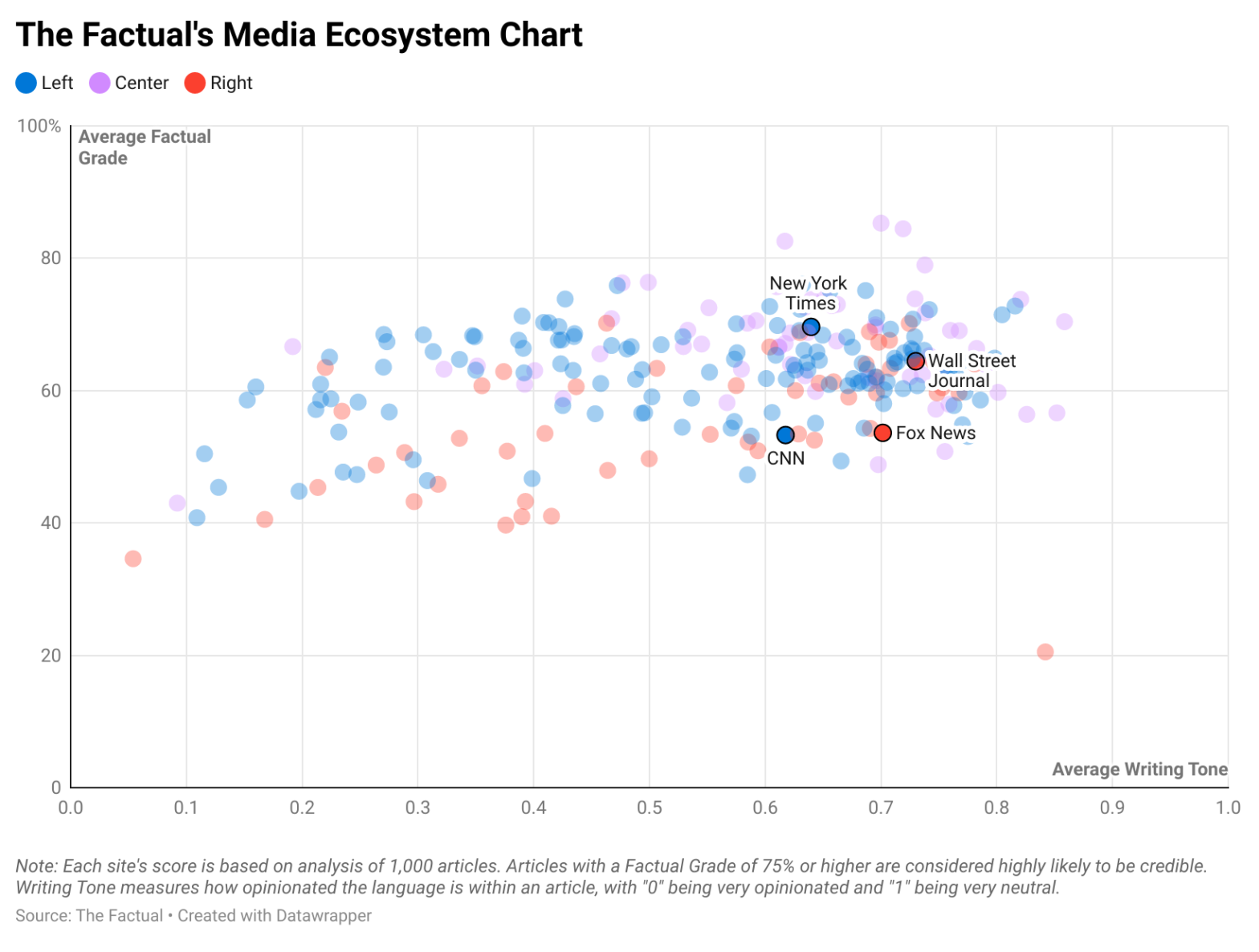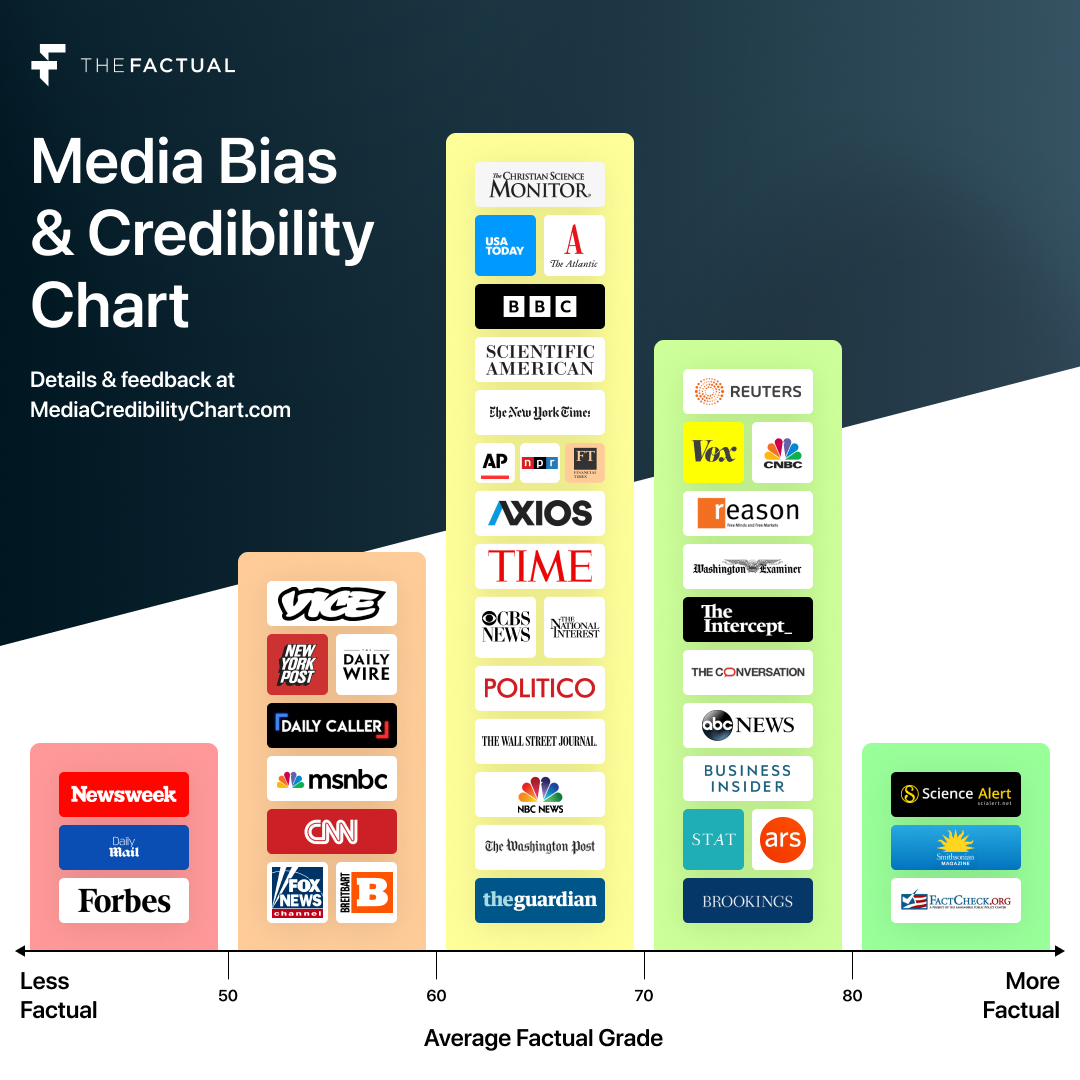Some of the simplest questions about the news can be hard to answer. Does CNN produce reliable news? Can Fox News be trusted? How biased is the New York Times?
Ideally, we wouldn’t need to ask these questions. However, a highly polarized political environment and an incessant drive for ad revenue have raised questions about bias and journalistic quality in the last decade.
Asking for completely unbiased news is a fool’s errand—bias is firmly a part of our world. The best we can do is to know and understand bias, read widely, and prioritize sources that attempt to provide highly factual, objective news. Using The Factual’s algorithm, it’s possible to explore which sites are closest to achieving that standard.
The Factual’s Media Ecosystem Chart
To identify which news sources consistently produce the very best articles, The Factual used its news-rating algorithm to compare the publication output of 240 major sources. The Factual scores individual articles based on four metrics: writing tone, cited evidence, author expertise, and publication history. When combined, these metrics produce a score from 0 to 100 that we call a Factual Grade. Essentially, an article that is well researched, minimally opinionated, written by a topical expert, and from a reputable source will score highly.
Next, we analyzed ~1,000 articles for each source. These samples are enough to create a reliable estimation of each site’s typical article output. When mapped out spatially, this data produces an interactive picture of the entire English-language news ecosystem.
Sources closer to the top of the graph score higher in terms of their average Factual Grade. For example, those sites were more likely to use extensive evidence, be written in a neutral tone, and come from authors with topical expertise.
Part of our study also involved mapping out how each source scored in terms of our metric Writing Tone. This is a measure of how opinionated or neutral the language is. In this case, sources with scores closer to 1 (the right side of the graph) were more likely to use unbiased, neutral language in their reporting. Conversely, articles closer to 0 (the left side of the graph) were more likely to be opinionated.
Please check your email for instructions to ensure that the newsletter arrives in your inbox tomorrow.
The combination provides a glimpse of the media ecosystem and a hint at which news sites actually produce the most factual, unbiased news. Hovering your mouse over the chart can reveal some interesting revelations. For example, it shows us that Reuters produces the stories with the most unbiased language. Similarly, science-focused publications excel at producing the most factual, well-researched news.
Can I Trust This News Source?
To make the most of the data, we are also investigating major news sites individually. This involves looking at how major sites scored and why they scored that way, including additional context about each publication and potential past controversies. Below is an ever-expanding list of in-depth investigations of individual news sites using our dataset and publicly available information:
- ABC News
- Al Jazeera
- American Spectator
- Ars Technica
- Associated Press
- The Atlantic
- BBC
- The Blaze
- Boston Globe
- Breitbart
- Business Insider
- CBS News
- CNBC
- CNN
- The Conversation
- Daily Beast
- Daily Caller
- Daily Mail
- Daily Mirror
- Deseret News
- FactCheck.org
- The Federalist
- FiveThirtyEight
- Forbes
- Foreign Policy
- Fox News
- The Guardian
- The Hill
- HuffPost
- The Intercept
- Jacobin
- LA Times
- MarketWatch
- Mediaite
- Mic
- MIT Technology Review
- Mother Jones
- MSNBC
- National Interest
- National Review
- NBC News
- New Republic
- New Scientist
- New York Post
- New York Times
- Newsweek
- NPR
- Pew Research
- Politico
- Quartz
- Raw Story
- RealClearPolitics
- Reason Magazine
- Red State
- Reuters
- RT
- Smithsonian Magazine
- SFGate
- STAT
- Texas Tribune
- Townhall
- USA Today
- Vox
- Wall Street Journal
- Washington Examiner
- Washington Post
- Washington Times
- The Week
Please check your email for instructions to ensure that the newsletter arrives in your inbox tomorrow.
Last updated on February 17, 2022 to reflect new data.




